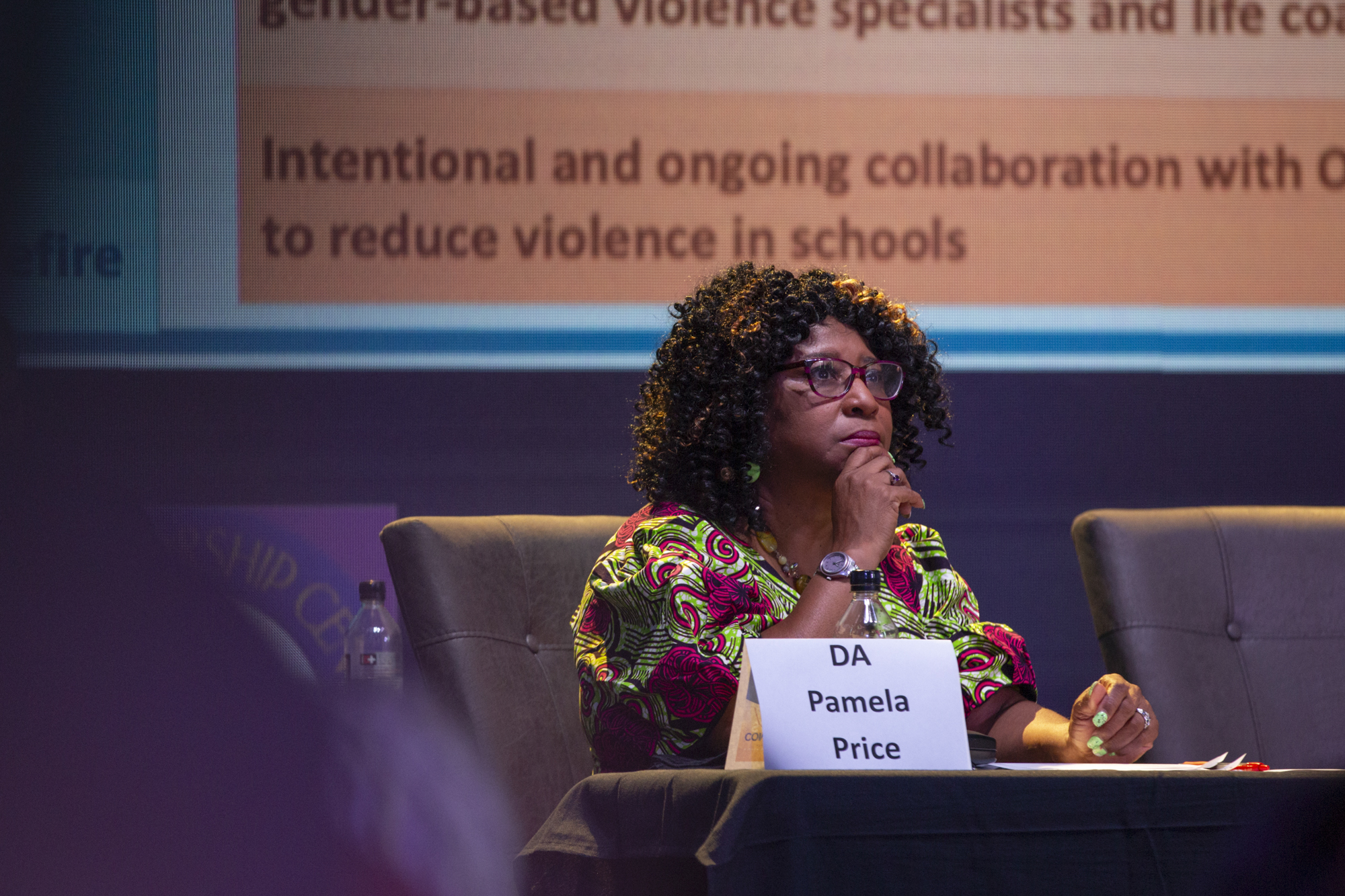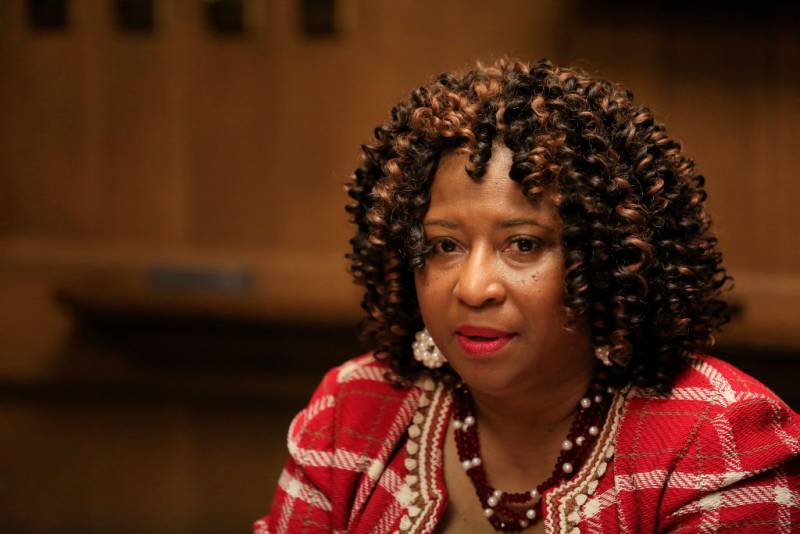A recall is rearing its head in the Bay Area again.
This time, the subject of some voters’ ire is Alameda County District Attorney Pamela Price. The criminal justice reformer has only been in office since January, but her detractors are pinning the blame for crime in Oakland on her shoulders.
The recall campaign is called Save Alameda for Everyone: Recall DA Price, or SAFE. Its proponents have criticized Price’s progressive policies, like not charging minors as adults, and for dropping “special circumstances” charges in high-profile cases, like the two men accused of killing toddler Jasper Wu in a freeway shoot-out. That decision will leave open the possibility of parole, which Price’s opponents decry.
California voters have seen recent recall efforts against former San Francisco District Attorney Chesa Boudin and Los Angeles County District Attorney George Gascón. But the rules are a bit different in Alameda County’s charter.
Adding an element of uncertainty, the Alameda County Registrar of Voters started the process to reform the county’s recall election rules in October. Alameda County recall law was written in 1926, and it’s out of date because it doesn’t leave nearly enough time to count signatures or administer an election, according to the Registrar of Voters. And if the registrar made a mistake in issuing the recall, the county could easily be sued.
In an attempt to make sense of the complicated election process and what a potential recall vote could look like, KQED researched state and county recall election law and spoke with the recall’s principal officer, Brenda Grisham, as well as political consultant Jim Ross, who consulted on Boudin’s unsuccessful campaign to thwart a recall.
Keep reading for a comprehensive look at the Alameda County District Attorney’s recall process. We’ll update this guide as more information becomes available.
Jump straight to a section:
- Who’s behind the Pamela Price recall attempt, and who’s funding it?
- How could this recall get on the ballot?
- How many signatures would the Price recall campaign need to collect?
- When would any recall election take place?
- Is this attempt similar to the 2022 recall of San Francisco District Attorney Chesa Boudin?
Who’s behind the Pamela Price recall attempt?
It isn’t entirely clear — yet. Here’s what we know from paperwork filed with Alameda County.
Brenda Grisham is the principal officer of the recall committee. Her 17-year-old son was shot and killed in East Oakland outside their home in 2010, leading her to pursue a career as a victim advocate.
Carl Chan, who leads the Oakland Chinatown Chamber of Commerce, is another officer on the committee. In 2021, he was allegedly assaulted in Oakland by a man who Chan said yelled “Chinaman” before punching him.
The committee’s final named officer is an Oakland resident named Philip Dreyfuss, a hedge fund partner at Farallon Capital Management, LLC. Dreyfuss was removed from later iterations of the committee’s filing documents and then formed his own campaign committee, Reviving the Bay Area.
Where’s the money for the Pamela Price recall attempt coming from?
The Save Alameda for Everyone: Recall DA Price committee has raised $212,000, according to campaign filings made public on Nov. 1.
While strict financial reporting requirements exist for groups raising money to place a measure on the ballot, SAFE’s donations have been structured in a way that obscures the identities of some donors. But, one of SAFE’s largest funding sources is Reviving the Bay Area. The group, started by hedge fund partner Dreyfuss, contributed an additional $300,000 to SAFE, some of which was to conduct polling. But Reviving the Bay Area hasn’t yet had to disclose its own funding sources.
It’s a common tactic in campaigns for donors to hide their true funding sources by nesting their donations in an almost Russian-doll-like fashion. One group funds another group, which funds another group, making the discovery of true donors more difficult.
Among SAFE’s donors publicly listed are CEOs, realtors, tech workers, attorneys, small business owners and retirees.
The California Secretary of State lays out a schedule for campaign committees trying to place a ballot measure during the March primary and November election to file financial statements:
- For the March primary, the key deadlines to report all contributions are Jan. 31, Feb. 22 and July 31.
- If the measure is headed for the November election, the reporting dates are: July 31, Sept. 26, Oct. 24, and Jan. 31, 2025.
- Some contributions may be made public within 24 hours if donated in large enough amounts ($1,000 or more).
While state recall rules make it likely a recall election would take place in November, Grisham told KQED that SAFE is aiming for a June special election. If that were to happen, the reporting dates for campaign funds would be newly drafted for that election.
If you want to search for the campaign finance disclosures for yourself, head to the Official Election Site of Alameda County and type in the names of the campaign committees to find their disclosure documents.

How could the Pamela Price recall get on the ballot?
Recalls, much like other ballot measures, include gathering signatures and filing paperwork to eventually make it to the ballot.
The state and county rules for recalls lay out this general path to the ballot:
- Register a committee to conduct the recall.
- File and publish a “notice of intention” to circulate a recall petition. The petition is the document you’d see outside a supermarket, for instance, as signature gatherers work.
- Obtain an official “answer” from the person being recalled.
- Make the recall petition public so the statement can be evaluated for false or misleading statements, or if it’s inconsistent with state law.
- Receive approval to circulate the recall petition to gather signatures.
- Determine the number of signatures needed.
- Begin circulating the recall petition to gather signatures.
- Submit the recall petition by a legal deadline.
Election officials then evaluate the signatures and determine if the measure goes to ballot.
The campaign against Price filed paperwork with the Alameda County Registrar of Voters to start the recall process in July. In October, SAFE was certified by the Alameda County Registrar of Voters.
The recall campaign now has more than 1,900 volunteers to gather the tens of thousands of signatures it needs to place a recall question on the ballot, Grisham told KQED.
But that process may not be so simple.
In late October, the Alameda County Board of Supervisors gave its first approval to a charter amendment that would change how the county administers recall elections. Instead of relying on its own charter, the county would essentially “delete” all of its local laws on recalls and use state rules instead. That’s not an anomaly in California as most counties default to state law for recall elections, according to the Registrar of Voters.
At an Oct. 24 Alameda County Board of Supervisors meeting, County Counsel Donna Ziegler told the board that recall rules similar to Alameda County’s have been found unconstitutional in other parts of the country.
“And so the goal of this amendment is to increase the possibility — the likelihood — that should there ever be an occasion for the county to actually conduct a recall election, that the [Registrar of Voters] has a fighting chance to actually conduct that election with integrity,” she said.
More than a dozen recall supporters spoke that night, including Grisham, who called out the potential rule changes as unfair.
“I feel that this is election interference, and we have no trust in any of the departments, any of the administration,” Grisham said during public comment. “Right now, we have no trust in the Registrar of Voters.”
The registrar has a history of major errors in elections. Just last year, the count employed an incorrect method of counting ballots in Oakland that resulted in the registrar crowning the wrong winner in an Oakland Unified School District race.
An elections commission formed in the wake of that scandal still has eight vacancies and has yet to officially meet, according to its website.
The difference between the state and county rules on recalls is key because each set of rules has distinct timelines and thresholds for a recall election. Alameda County voters will have the opportunity to vote on changing — or keeping — the county’s recall rules on March 5, 2024.
How many signatures would the Price recall campaign need to collect?
State rules say the recall campaign has 160 days to gather signatures. County recall rules don’t specify a time frame.
The number of signatures needed to get a recall on the ballot is another significant difference between the state and county rules. State rules, for instance, say that for Alameda County, the number of signatures gathered must equal 10% of registered voters — about 93,000 signatures.
But county regulations say the amount of signatures must be equal in number to at least 15% of the entire vote cast for governor candidates in the last gubernatorial election. Calculating the number of Alameda County voters who cast a ballot for either Gov. Gavin Newsom or state Sen. Brian Dahle, that number is just over 70,000 signatures.
Having to gather an additional 20,000 signatures may cost a campaign more than $200,000, political consultant Jim Ross said. Could that imperil the recall effort?
“Signature gathering is all about money,” Ross said. “If they have the money to hire or pay signature gatherers, then they’ll qualify.”
Grisham said SAFE aims to meet the 93,000 signature goal to ensure the campaign qualifies under either set of rules.
